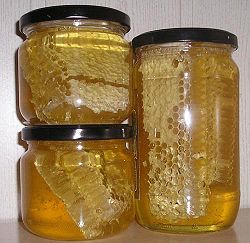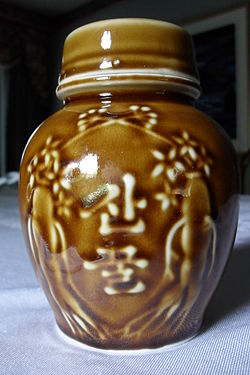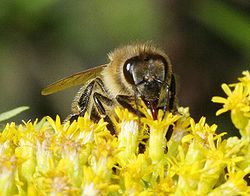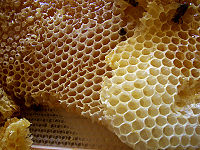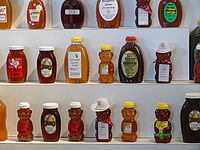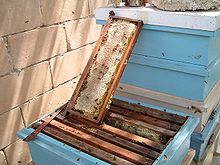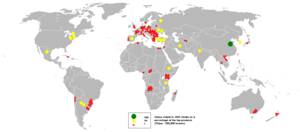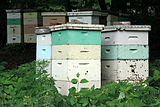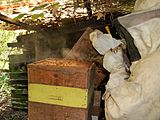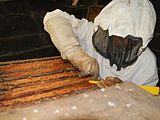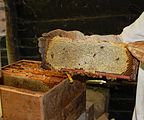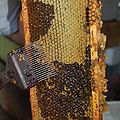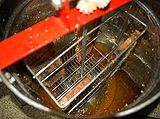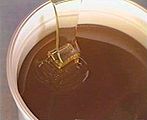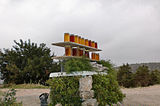- Honey
-
For other uses, see Honey (disambiguation).Traditional honey pot from North Korea
Honey (English pronunciation: /ˈhʌni/) is a sweet food made by bees using nectar from flowers. The variety produced by honey bees (the genus Apis) is the one most commonly referred to and is the type of honey collected by beekeepers and consumed by humans. Honey produced by other bees and insects has distinctly different properties.
Honey bees transform nectar into honey by a process of regurgitation, and store it as a primary food source in wax honeycombs inside the beehive. Beekeeping practices encourage overproduction of honey so the excess can be taken from the colony.
Honey gets its sweetness from the monosaccharides fructose and glucose, and has approximately the same relative sweetness as that of granulated sugar.[1][2] It has attractive chemical properties for baking, and a distinctive flavor that leads some people to prefer it over sugar and other sweeteners.[1] Most microorganisms do not grow in honey because of its low water activity of 0.6.[3] However, honey sometimes contains dormant endospores of the bacterium Clostridium botulinum, which can be dangerous to infants, as the endospores can transform into toxin-producing bacteria in the infant's immature intestinal tract, leading to illness and even death[4] (see Health hazards below).
Honey has a long history of human consumption, and is used in various foods and beverages as a sweetener and flavoring. It also has a role in religion and symbolism. Flavors of honey vary based on the nectar source, and various types and grades of honey are available. It is also used in various medicinal traditions to treat ailments. The study of pollens and spores in raw honey (melissopalynology) can determine floral sources of honey.[5] Because bees carry an electrostatic charge, and can attract other particles, the same techniques of melissopalynology can be used in area environmental studies of radioactive particles, dust or particulate pollution.[6][7]
Formation
Honey is produced by bees as a food source. In cold weather or when fresh food sources are scarce, bees use their stored honey as their source of energy.[8] By contriving for bee swarms to nest in artificial hives, people have been able to semidomesticate the insects, and harvest excess honey. In the hive (or in a wild nest), there are three types of bee in a hive: a single female queen bee, a seasonally variable number of male drone bees to fertilize new queens, and some 20,000 to 40,000 female worker bees.[9] The worker bees raise larvae and collect the nectar that will become honey in the hive. Leaving the hive, they collect sugar-rich flower nectar and return.
In the hive, the bees use their "honey stomachs" to ingest and regurgitate the nectar a number of times until it is partially digested.[10] The bees work together as a group with the regurgitation and digestion until the product reaches a desired quality. It is then stored in honeycomb cells. After the final regurgitation, the honeycomb is left unsealed. However, the nectar is still high in both water content and natural yeasts, which, unchecked, would cause the sugars in the nectar to ferment.[8] The process continues as bees inside the hive fan their wings, creating a strong draft across the honeycomb, which enhances evaporation of much of the water from the nectar.[8] This reduction in water content raises the sugar concentration and prevents fermentation. Ripe honey, as removed from the hive by a beekeeper, has a long shelf life, and will not ferment if properly sealed.[8]
Physical properties
The physical properties of honey vary, depending on water content, the type of flora used to produce it, temperature, and the proportion of the specific sugars it contains. Fresh honey is a supersaturated liquid, containing more sugar than the water can typically dissolve at ambient temperatures. At room temperature, honey is a supercooled liquid, in which the glucose will precipitate into solid granules. This forms a semisolid solution of precipitated sugars in a solution of sugars and other ingredients.
The melting point of crystallized honey is between 40 and 50 °C (104 and 122 °F), depending on its composition. Below this temperature, honey can be either in a metastable state, meaning that it will not crystallize until a seed crystal is added, or, more often, it is in a "labile" state, being saturated with enough sugars to crystallize spontaneously.[11] The rate of crystallization is affected by the ratio of the main sugars, fructose to glucose, as well as the dextrin content. Temperature also affects the rate of crystallization, which is fastest between 13 and 17 °C (55 and 63 °F). Below 5 °C, the honey will not crystallize and, thus, the original texture and flavor can be preserved indefinitely.[12]
Since honey normally exists below its melting point, it is a supercooled liquid. At very low temperatures, honey will not freeze solid. Instead, as the temperatures become colder, the viscosity of honey increases. Like most viscous liquids, the honey will become thick and sluggish with decreasing temperature. While appearing or even feeling solid, it will continue to flow at very slow rates. Honey has a glass transition between -42 and -51 °C (-44 and -60 °F). Below this temperature, honey enters a glassy state and will become a noncrystalline amorphous solid.[13][14]
The viscosity of honey is affected greatly by both temperature and water content. The higher the humidity, the easier honey will flow. Above its melting point, however, water has little effect on viscosity. Aside from water content, the composition of honey also has little effect on viscosity, with the exception of a few types. At 25 °C (77 °F), honey with 14% humidity will generally have a viscosity of around 400 poise, while a honey containing 20% humidity will have a viscosity of around 20 poise. Viscosity increase due to temperature occurs very slowly at first. A honey containing 16% humidity, at 70 °C (158 °F), will have a viscosity of around 2 poise, while at 30 °C (86 °F), the viscosity will be around 70 poise. As cooling progresses, honey will become more viscous at an increasingly rapid rate, reaching 600 poise around 14 °C (57 °F). However, while honey is very viscous, it has rather low surface tension.[15][16]
A few types of honey have unusual viscous properties. Honey from heather or manuka display thixotropic properties. These types of honey enter a gel-like state when motionless, but then liquify when stirred.[17]
Unlike many other liquids, honey has very poor thermal conductivity. Melting crystallized honey can easily result in localized caramelization if the heat source is too hot, or if it is not evenly distributed. However, honey will take substantially longer to liquify when just above the melting point than it will at elevated temperatures.[16]
Since honey contains electrolytes, in the form of acids and minerals, it exhibits varying degrees of electrical conductivity. Measurements of the electrical conductivity are used to determine the quality of honey in terms of ash content.[16]
The effect honey has on light is useful for determining the type and quality. Variations in the water content alter the refractive index of honey. Water content can easily be measured with a refractometer. Typically, the refractive index for honey will range from 1.504 at 13% humidity, to 1.474 at 25%. Honey also has an effect on polarized light, in that it will rotate the polarization plane. The fructose will give a negative rotation, while the glucose will give a positive one. The overall rotation can be used to measure the ratio of the mixture.[16][18]
Honey has the ability to absorb moisture directly from the air, a phenomenon called hygroscopy. The amount of water the honey will absorb is dependent on the relative humidity of the air. This hygroscopic nature requires that honey be stored in sealed containers to prevent fermentation. Honey will tend to absorb more water in this manner than the individual sugars would allow on their own, which may be due to other ingredients it contains.[18]
In history, culture, and folklore
Honey use and production has a long and varied history. In many cultures, honey has associations that go beyond its use as a food. Honey is frequently used as a talisman and symbol of sweetness.[citation needed]
Ancient times
Honey collection is an ancient activity. Humans apparently began hunting for honey at least 10,000 years ago, as evidenced by a cave painting in Valencia, Spain.[19] The painting is a Mesolithic rock painting, showing two female honey-hunters collecting honey and honeycomb from a wild bee nest. The two women are depicted in the nude, carrying baskets, and using a long, wobbly ladder to reach the wild nest.
In ancient Egypt, honey was used to sweeten cakes and biscuits, and was used in many other dishes. Ancient Egyptian and Middle Eastern peoples also used honey for embalming the dead.[20] Pliny the Elder devotes considerable space in his book Naturalis Historia to the bee and honey, and its many uses. The fertility god of Egypt, Min, was offered honey.[21]
The art of beekeeping in ancient China has existed since time immemorial and appears to be untraceable to its origin. In the book "Golden Rules of Business Success" written by Fan Li (or Tao Zhu Gong) during the Spring and Autumn Period, there are some parts mentioning the art of beekeeping and the importance of the quality of the wooden box for bee keeping that can affect the quality of its honey.
Honey was also cultivated in ancient Mesoamerica. The Maya used honey from the stingless bee for culinary purposes, and continue to do so today. The Maya also regard the bee as sacred (see Mayan stingless bees of Central America).
Some cultures believed honey had many practical health uses. It was used as an ointment for rashes and burns, and to help soothe sore throats when no other medicinal practices were available.
Religious significance
In Hinduism, honey (Madhu) is one of the five elixirs of immortality (Panchamrita). In temples, honey is poured over the deities in a ritual called Madhu abhisheka. The Vedas and other ancient literature mention the use of honey as a great medicinal and health food.
In Jewish tradition, honey is a symbol for the new year, Rosh Hashanah. At the traditional meal for that holiday, apple slices are dipped in honey and eaten to bring a sweet new year. Some Rosh Hashanah greetings show honey and an apple, symbolizing the feast. In some congregations, small straws of honey are given out to usher in the new year.
The Hebrew Bible contains many references to honey. In the Book of Judges, Samson found a swarm of bees and honey in the carcass of a lion (14:8). The Book of Exodus famously describes the Promised Land as a "land flowing with milk and honey" (33:3). However, the claim has been advanced that the original Hebrew (דבש devash) actually refers to the sweet syrup produced from the juice of dates.[22][23] Pure honey is considered kosher even though it is produced by a flying insect, a nonkosher creature; other products of nonkosher animals are not kosher.[24]
In Buddhism, honey plays an important role in the festival of Madhu Purnima, celebrated in India and Bangladesh. The day commemorates Buddha's making peace among his disciples by retreating into the wilderness. The legend has it that while he was there, a monkey brought him honey to eat. On Madhu Purnima, Buddhists remember this act by giving honey to monks. The monkey's gift is frequently depicted in Buddhist art.
In the Christian New Testament, Matthew 3:4, John the Baptist is said to have lived for a long period of time in the wilderness on a diet consisting of locusts and wild honey.
In Islam, there is an entire Surah in the Qur'an called al-Nahl (the Honey Bee). According to hadith, Prophet Muhammad strongly recommended honey for healing purposes.[25] The Qur'an promotes honey as a nutritious and healthy food. Below is the English translation of those specific verses.
And your Lord inspired the female bee(s), saying: "Take you habitations in the mountains and in the trees and in what they erect. (68) Then, eat of all fruits, and follow the ways of your Lord made easy (for you)." There comes forth from their bellies, a drink of varying colour wherein is healing for men. Verily, in this is indeed a sign for people who think.[26]
In western culture
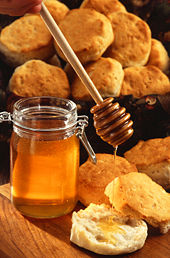 A jar of honey with honey dipper
A jar of honey with honey dipper
The word "honey", along with variations like "honey bun" and the abbreviation "hon", has become a term of endearment in most of the English-speaking world. In some places it is used for loved ones; in others, such as Australia, the Southern United States and Baltimore, Maryland, it is used when addressing casual acquaintances or even strangers.
In many children’s books, bears are depicted as eating honey (e.g., Winnie the Pooh), though most bears actually eat a wide variety of foods, and bears seen at beehives are usually more interested in bee larvae than honey.[27] In some European languages, even the word for bear (e.g. in Russian медвед medvéd, in Polish niedźwiedź, in Czech medvěd, in Serbian медвед medved, in Bosnian medvjed in Croatian medvjed/međed and in Hungarian medved) is coined from the noun meaning honey and the verb meaning to eat, thus "honey eater."[28] Honey is sometimes sold in bear-shaped jars or squeeze bottles.
Collecting honey
Honey is collected from wild bee colonies, or from domesticated beehives. Wild bee nests are sometimes located by following a honeyguide bird.
Collecting honey is typically achieved by using smoke from a bee smoker to pacify the bees; this causes the bees to attempt to save the resources of the hive from a possible forest fire, and makes them far less aggressive. The honeycomb is removed from the hive and the honey is extracted from that, often using a honey extractor. The honey is then filtered.
Modern uses
As a food and in cooking
The main uses of honey are in cooking, baking, as a spread on bread, and as an addition to various beverages, such as tea, and as a sweetener in some commercial beverages. According to the The National Honey Board (a USDA-overseen organization), "honey stipulates a pure product that does not allow for the addition of any other substance...this includes, but is not limited to, water or other sweeteners".[29] Honey barbecue and honey mustard are common and popular sauce flavors.
Honey is the main ingredient in the alcoholic beverage mead, which is also known as "honey wine" or "honey beer". Historically, the ferment for mead was honey's naturally occurring yeast. Honey is also used as an adjunct in some beers.
Honey wine, or Mead, is typically (modern era) made with a honey and water mixture with a pack of yeast added for fermentation. Primary fermentation usually takes 40 days, after which the must needs to be racked into a secondary fermentation vessel and left to sit about 35–40 more days. The Mead will take about 9 months to fully ferment with a racking (moving the mead into a new vessel) every 35 days.
Nutrition
Honey Nutritional value per 100 g (3.5 oz) Energy 1,272 kJ (304 kcal) Carbohydrates 82.4 g - Sugars 82.12 g - Dietary fiber 0.2 g Fat 0 g Protein 0.3 g Water 17.10 g Riboflavin (vit. B2) 0.038 mg (3%) Niacin (vit. B3) 0.121 mg (1%) Pantothenic acid (B5) 0.068 mg (1%) Vitamin B6 0.024 mg (2%) Folate (vit. B9) 2 μg (1%) Vitamin C 0.5 mg (1%) Calcium 6 mg (1%) Iron 0.42 mg (3%) Magnesium 2 mg (1%) Phosphorus 4 mg (1%) Potassium 52 mg (1%) Sodium 4 mg (0%) Zinc 0.22 mg (2%) Shown is for 100 g, roughly 5 tbsp.
Percentages are relative to US recommendations for adults.
Source: USDA Nutrient DatabaseHoney is a mixture of sugars and other compounds. With respect to carbohydrates, honey is mainly fructose (about 38.5%) and glucose (about 31.0%),[1] making it similar to the synthetically produced inverted sugar syrup, which is approximately 48% fructose, 47% glucose, and 5% sucrose. Honey's remaining carbohydrates include maltose, sucrose, and other complex carbohydrates.[1] As with all nutritive sweeteners, honey is mostly sugars and contains only trace amounts of vitamins or minerals.[30][31] Honey also contains tiny amounts of several compounds thought to function as antioxidants, including chrysin, pinobanksin, vitamin C, catalase, and pinocembrin.[32][33][vague] The specific composition of any batch of honey depends on the flowers available to the bees that produced the honey.[30]
Typical honey analysis:[34]
- Fructose: 38.2%
- Glucose: 31.3%
- Maltose: 7.1%
- Sucrose: 1.3%
- Water: 17.2%
- Higher sugars: 1.5%
- Ash: 0.2%
- Other/undetermined: 3.2%
Its glycemic index ranges from 31 to 78, depending on the variety.[35]
Honey has a density of about 1.36 kilograms per litre (36% denser than water).[36]
Isotope ratio mass spectrometry can be used to detect addition of corn syrup or sugar cane sugars by the carbon isotopic signature. Addition of sugars originating from corn or sugar cane (C4 plants, unlike the plants used by bees, which are predominantly C3 plants) skews the isotopic ratio of sugars present in honey, but does not influence the isotopic ratio of proteins; in an unadulterated honey, the carbon isotopic ratios of sugars and proteins should match. As low as 7% level of addition can be detected.[37][dead link]
Classification
Honey is classified by its floral source, and there are also divisions according to the packaging and processing used. There are also regional honeys. Honey is also graded on its color and optical density by USDA standards, graded on a scale called the Pfund scale, which ranges from 0 for "water white" honey to more than 114 for "dark amber" honey.[38]
Floral source
Generally, honey is classified by the floral source of the nectar from which it was made. Honeys can be from specific types of flower nectars, from indeterminate origin, or can be blended after collection.
Blended
Most commercially available honey is blended, meaning it is a mixture of two or more honeys differing in floral source, color, flavor, density or geographic origin.[39]
Polyfloral
Polyfloral honey, also known as wildflower honey,[40] is derived from the nectar of many types of flowers.[41] The taste may vary from year to year, and the aroma and the flavor can be more or less intense, depending on which bloomings are prevalent.[42]
Monofloral
Monofloral honey is made primarily from the nectar of one type of flower. Different monofloral honeys have a distinctive flavor and color because of differences between their principal nectar sources.[43] To produce monofloral honey, beekeepers keep beehives in an area where the bees have access to only one type of flower. In practice, because of the difficulties in containing bees, a small proportion of any honey will be from additional nectar from other flower types. Typical examples of North American monofloral honeys are clover, orange blossom, sage, tupelo, buckwheat, fireweed, and sourwood. Some typical European examples include thyme, thistle, heather, acacia, dandelion, sunflower, honeysuckle, and varieties from lime and chestnut trees. In North Africa, such as Egypt, examples include clover, cotton, and citrus (mainly orange blossoms).
Honeydew honey
Instead of taking nectar, bees can take honeydew, the sweet secretions of aphids or other plant sap-sucking insects. Honeydew honey is very dark brown in color, with a rich fragrance of stewed fruit or fig jam, and is not sweet like nectar honeys.[43] Germany's Black Forest is a well known source of honeydew-based honeys, as well as some regions in Bulgaria and Northern California in the United States. In Greece, pine honey (a type of honeydew honey) constitutes 60–65% of the annual honey production.[44] Honeydew honey is popular in some areas, but in other areas beekeepers have difficulty selling the stronger flavored product.
The production of honeydew honey has some complications and dangers. The honey has a much larger proportion of indigestibles than light floral honeys, thus causing dysentery to the bees, resulting in the death of colonies in areas with cold winters. Good beekeeping management requires the removal of honeydew prior to winter in colder areas. Bees collecting this resource also have to be fed protein supplements, as honeydew lacks the protein-rich pollen accompaniment gathered from flowers.
Classification by packaging and processing
Generally, honey is bottled in its familiar liquid form. However, honey is sold in other forms, and can be subjected to a variety of processing methods.
- Crystallized honey is honey in which some of the glucose content has spontaneously crystallized from solution as the monohydrate. Also called "granulated honey." Honey that has crystallized over time (or commercially purchased crystallized) in the home can be returned to a liquid state if stirred in a container sitting in warm water at 120 °F (approx 49 °C).[45]
- Pasteurized honey is honey that has been heated in a pasteurization process (161 °F (71.7 °C) or higher). Pasteurization destroys yeast cells. It also liquefies any microcrystals in the honey, which delays the onset of visible crystallization. However, excessive heat exposure also results in product deterioration, as it increases the level of hydroxymethylfurfural (HMF) and reduces enzyme (e.g. diastase) activity. Heat also affects appearance (darkens the natural honey color), taste, and fragrance.[46]
- Raw honey is honey as it exists in the beehive or as obtained by extraction, settling or straining, without adding heat (although some honey that has been "minimally processed" is often labeled as raw honey).[47] Raw honey contains some pollen and may contain small particles of wax. Local raw honey is sought after by allergy sufferers as the pollen impurities are thought to lessen the sensitivity to hay fever (see Other medical applications below).
- Strained honey has been passed through a mesh material to remove particulate material (pieces of wax, propolis, other defects) without removing pollen, minerals or enzymes.
- Ultrafiltered honey is processed by very fine filtration under high pressure to remove all extraneous solids and pollen grains. The process typically heats honey to 150–170 °F (approx. 65–77 °C) to more easily pass through the fine filter. Ultrafiltered honey is very clear and has a longer shelf life; it crystallizes more slowly because the high temperature breaks down sugar seed crystals, making it preferred by the supermarket trade.
- Ultrasonicated honey has been processed by ultrasonication, a nonthermal processing alternative for honey. When honey is exposed to ultrasonication, most of the yeast cells are destroyed. Those cells that survive sonication generally lose their ability to grow, which reduces the rate of honey fermentation substantially. Ultrasonication also eliminates existing crystals and inhibits further crystallization in honey. Ultrasonically aided liquefaction can work at substantially lower temperatures of approximately 95 °F (35 °C) and can reduce liquefaction time to less than 30 seconds.[48]
- Whipped honey, also called creamed honey, spun honey, churned honey, candied honey, honey fondant, and set honey (in the UK), has been processed to control crystallization. Whipped honey contains a large number of small crystals in the honey. The small crystals prevent the formation of larger crystals that can occur in unprocessed honey. The processing also produces a honey with a smooth, spreadable consistency.
- Dried honey has the moisture extracted from liquid honey to create completely solid, nonsticky granules. This process may or may not include the use of drying and anticaking agents. Dried honey is commonly used to garnish desserts.
- Comb honey is honey still in the honeybees' wax comb. It traditionally is collected by using standard wooden frames in honey supers. The frames are collected and the comb is cut out in chunks before packaging. As an alternative to this labor intensive method, plastic rings or cartridges can be used that do not require manual cutting of the comb, and speed packaging. Comb honey harvested in the traditional manner is also referred to as "cut-comb honey".[49] In India, honey is harvested from forests in bee's natural habitat. It is said that honey will be consumed by the bees on the new moon day, so it is cultivated the day before.
- Chunk honey is packed in widemouth containers consisting of one or more pieces of comb honey immersed in extracted liquid honey.
Preservation
Because of its unique composition and chemical properties, honey is suitable for long-term storage, and is easily assimilated even after long preservation. Honey, and objects immersed in honey, have been preserved for decades and even centuries.[50][51] The key to preservation is limiting access to humidity. In its cured state, honey has a sufficiently high sugar content to inhibit fermentation. If exposed to moist air, its hydrophilic properties will pull moisture into the honey, eventually diluting it to the point that fermentation can begin. Honey sealed in honeycomb cells by the bees is considered by many[who?] to be the ideal form for preservation.
Honey should also be protected from oxidation and temperature degradation. It generally should not be preserved in metal containers because the acids in the honey may promote oxidation of the vessel. Traditionally, honey was stored in ceramic or wooden containers; however, glass and plastic are now the favored materials. Honey stored in wooden containers may be discolored or take on flavors imparted from the vessel. Likewise, honey stored uncovered near other foods may absorb other smells.
Excessive heat can have detrimental effects on the nutritional value of honey.[52][53] Heating up to 37 °C (98.6 °F) causes loss of nearly 200 components, some of which are antibacterial. Heating up to 40 °C (104 °F) destroys invertase, an important enzyme. At 50 °C (122 °F), the honey sugars caramelize. Generally, any large temperature fluctuation causes decay.[54]
Regardless of preservation, honey may crystallize over time. Crystallization does not affect the flavor, quality or nutritional content of the honey, though it does affect color and texture. The rate is a function of storage temperature, availability of "seed" crystals and the specific mix of sugars and trace compounds in the honey. Tupelo and acacia honeys, for example, are exceptionally slow to crystallize, while goldenrod will often crystallize still in the comb. Most honeys crystallize fastest between about 50 and 70 °F (10 and 21 °C). The crystals can be redissolved by heating the honey.
Distinguishing honey
Honey grading
In the US, honey grading is performed voluntarily (USDA does offer inspection and grading "as on-line (in-plant) or lot inspection...upon application, on a fee-for-service basis.") based upon USDA standards. Honey is graded based upon a number of factors, including water content, flavor and aroma, absence of defects and clarity. Honey is also classified by color though it is not a factor in the grading scale. [55] The honey grade scale is:
Grade Water content Flavor and aroma Absence of defects Clarity A < 18.6% Good—has a good, normal flavor and aroma for the predominant floral source and is free from caramelization, smoke, fermentation, chemicals and other odor causes Practically free—practically no defects that affect appearance or edibility Clear—may contain air bubbles that do not materially affect the appearance; may contain a trace of pollen grains or other finely divided particles of suspended material that do not affect appearance B < 18.6% Reasonably good—practically free from caramelization; free from smoke, fermentation, chemicals, and other causes Reasonably free—do not materially affect appearance or edibility Reasonably clear—may contain air bubbles, pollen grains, or other finely divided particles of suspended material that do not materially affect appearance C < 20.0% Fairly good—reasonably free from caramelization; free from smoke, fermentation, chemicals, and other causes Fairly free—do not seriously affect the appearance or edibility Fairly clear—may contain air bubbles, pollen grains, or other finely divided particles of suspended material that do not seriously affect appearance Substandard > 20.0% Fails Grade C Fails Grade C Fails Grade C Other countries may have differing standards on the grading of honey. India, for example, certifies honey grades based on additional factors, such as the Fiehe's test, and other empirical measurements.[56]
Indicators of quality
High-quality honey can be distinguished by fragrance, taste, and consistency. Ripe, freshly collected, high-quality honey at 20 °C (68 °F) should flow from a knife in a straight stream, without breaking into separate drops.[57] After falling down, the honey should form a bead. The honey, when poured, should form small, temporary layers that disappear fairly quickly, indicating high viscosity. If not, it indicates excessive water content (over 20%)[57] of the product. Honey with excessive water content is not suitable for long-term preservation.[58]
In jars, fresh honey should appear as a pure, consistent fluid, and should not set in layers. Within a few weeks to a few months of extraction, many varieties of honey crystallize into a cream-colored solid. Some varieties of honey, including tupelo, acacia, and sage, crystallize less regularly. Honey may be heated during bottling at temperatures of 40–49°C (104–120°F) to delay or inhibit crystallization. Overheating is indicated by change in enzyme levels, for instance, diastase activity, which can be determined with the Schade or the Phadebas methods. A fluffy film on the surface of the honey (like a white foam), or marble-colored or white-spotted crystallization on a containers sides, is formed by air bubbles trapped during the bottling process.
A 2008 Italian study determined nuclear magnetic resonance spectroscopy can be used to distinguish between different honey types, and can be used to pinpoint the area where it was produced. Researchers were able to identify differences in acacia and polyfloral honeys by the differing proportions of fructose and sucrose, as well as differing levels of aromatic amino acids phenylalanine and tyrosine. This ability allows greater ease of selecting compatible stocks.[59]
In medicine
Historically, honey has been used by humans to treat a variety of ailments through topical application, but only recently have the antiseptic and antibacterial properties of honey been chemically explained.
In Ayurveda, a 4000-year-old medicine originating from India, honey is considered to positively affect all three primitive material imbalances of the body. "Vaatalam guru sheetam cha raktapittakaphapaham| Sandhatru cchedanam ruksham kashayam madhuram madhu|| "It has sweetness with added astringent as end taste. It is heavy, dry and cold. Its effect on doshas (imbalances) is that it aggravates vata (air / moving forces), scrapes kapha (mucus / holding forces) and normalizes pitta (catabolic fire) and rakta (blood). It promotes the healing process." Some wound gels which contain antibacterial raw honey and have regulatory approval are now available to help treat drug-resistant strains of bacteria (MRSA). One New Zealand researcher says a particular type of honey (Manuka honey) may be useful in treating MRSA infections.[60])
As an antimicrobial agent honey may have the potential for treating a variety of ailments. Antibacterial properties of honey are the result of the low water activity causing osmosis, chelation of free Iron, its slow release of hydrogen peroxide,[61] high acidity,[62] and the antibacterial activity of methylglyoxal.[63]
Honey appears to be effective in killing drug-resistant biofilms which are implicated in chronic rhinosinusitis.[64]
Osmotic effect
Honey is primarily a saturated mixture of two monosaccharides, with a low water activity; most of the water molecules are associated with the sugars and few remain available for microorganisms, so it is a poor environment for their growth. If water is mixed with honey, it loses its low water activity, and therefore no longer possesses this antimicrobial property.
Hydrogen peroxide
Hydrogen peroxide is formed in a slow-release manner by the enzyme glucose oxidase present in honey. It becomes active only when honey is diluted, requires oxygen to be available for the reaction (thus it may not work under wound dressings, in wound cavities or in the gut), is active only when the acidity of honey is neutralized by body fluids, can be destroyed by the protein-digesting enzymes present in wound fluids, and is destroyed when honey is exposed to heat and light.[63] Honey chelates and deactivates free iron, which would otherwise catalyze the formation of oxygen free radicals from hydrogen peroxide, leading to inflammation. Also, the antioxidant constituents in honey help clean up oxygen free radicals present.[65]
When honey is used topically (as, for example, a wound dressing), hydrogen peroxide is produced by dilution of the honey with body fluids. As a result, hydrogen peroxide is released slowly and acts as an antiseptic.
Use for diabetic ulcers
Topical honey has been used successfully in a comprehensive treatment of diabetic ulcers when the patient cannot use topical antibiotics.[66]
Acidity
The pH of honey is commonly between 3.2 and 4.5.[62] This relatively acidic pH level prevents the growth of many bacteria.
Methylglyoxal
The nonperoxide antibiotic activity is due to methylglyoxal (MGO) and an unidentified synergistic component. Most honeys contain very low levels of MGO, but manuka honey contains very high levels. The presence of the synergist in manuka honey more than doubles MGO antibacterial activity.[63]
Nutraceutical effects
Antioxidants in honey have even been associated with reducing the damage done to the colon in colitis in a study involving administering honey enamas to rats.[67] Such claims are consistent with its use in many traditions of folk medicine.[68]
Use for sore throats and coughs
Honey has also been used for centuries as a treatment for sore throats and coughs and, according to recent research, may be an effective soothing agent for coughs.[69]
Other medical applications
Some studies suggest the topical use of honey may reduce odors, swelling, and scarring when used to treat wounds; it may also prevent the dressing from sticking to the healing wound.[62]
Honey has been shown to be an effective treatment for conjunctivitis in rats.[70]
Unfiltered, pasteurized honey is widely believed to alleviate allergies, though neither commercially filtered nor raw honey was shown to be more effective than placebo in a controlled study of 36 participants with ocular allergies.[71] Nearly 1 in 3 of the volunteers dropped out of the study because they couldn’t tolerate eating one tablespoon of honey every day due to the overly sweet taste.[72] The official conclusion: "This study does not confirm the widely held belief that honey relieves the symptoms of allergic rhinoconjunctivitis." A more recent study has shown pollen collected by bees to exert an antiallergenic effect, mediated by an inhibition of IgE immunoglobulin binding to mast cells. This inhibited mast cell degranulation and thus reduced allergic reaction.[73] The risk of experiencing anaphylaxis as an immune system reaction may outweigh any potential allergy relief.[72]
A review in the Cochrane Library suggests honey could reduce the time it takes for a burn to heal — up to four days sooner in some cases. The review included 19 studies with 2,554 participants. Although the honey treatment healed moderate burns faster than traditional dressings did, the author recommends viewing the findings with caution, since a single researcher performed all of the burn studies.[74]
Health hazards
Botulism
Because of the natural presence of botulinum endospores in honey,[75] children under one year of age should not be given honey. The more-developed digestive system of older children and adults generally destroys the spores. Infants, however, can contract botulism from honey.[76] Medical grade honey can be treated with gamma radiation to reduce the risk of botulinum spores being present.[77] Gamma radiation evidently does not affect honey's antibacterial activity, whether or not the particular honey's antibacterial activity is dependent upon peroxide generation.[78]
Infantile botulism shows geographical variation. In the UK, only six cases have been reported between 1976 and 2006,[79] yet the U.S. has much higher rates: 1.9 per 100,000 live births, 47.2% of which are in California.[80] Although honey has been implicated as a risk factor for infection, it is household dust that is the major source of spores. Therefore, the risk honey poses to infant health is small, if uncertain.[81]
Toxic honey
Main article: Bees and toxic chemicals#Toxic honeyHoney produced from the flowers of oleanders, rhododendrons, mountain laurels, sheep laurel, and azaleas may cause honey intoxication. Symptoms include dizziness, weakness, excessive perspiration, nausea, and vomiting. Less commonly, low blood pressure, shock, heart rhythm irregularities, and convulsions may occur, with rare cases resulting in death. Honey intoxication is more likely when using "natural" unprocessed honey and honey from farmers who may have a small number of hives. Commercial processing, with pooling of honey from numerous sources, generally dilutes any toxins.[82]
New Zealand
Toxic honey may also result when bees are proximate to tutu bushes (Coriaria arborea) and the vine hopper insect (Scolypopa australis). Both are found throughout New Zealand. Bees gather honeydew produced by the vine hopper insects feeding on the tutu plant. This introduces the poison tutin into honey.[83] Only a few areas in New Zealand (Coromandel Peninsula, Eastern Bay of Plenty and the Marlborough Sound) frequently produce toxic honey. Symptoms of tutin poisoning include vomiting, delirium, giddiness, increased excitability, stupor, coma, and violent convulsions. To reduce the risk of tutin poisoning, humans should not eat honey taken from feral hives in the risk areas of New Zealand. Since December 2001, New Zealand beekeepers have been required to reduce the risk of producing toxic honey by closely monitoring tutu, vine hopper, and foraging conditions within 3 km of their apiary.
Honey-producing countries
In 2005, China, Argentina, Turkey and the United States were the top producers of natural honey, reports the Food and Agriculture Organization of the United Nations (FAO).
Significant regional producers of honey include Turkey (ranked third worldwide) and Ukraine (ranked fifth worldwide).[84]
Mexico is also an important producer of honey, providing about 10% of the world's supply[citation needed]. Much of this (about one-third) comes from the Yucatán Peninsula. Honey production began there when the Apis mellifera and the A. mellifera ligustica were introduced there early in the 20th century. Most of Mexico's Yucatán producers are small, family operations who use original traditional techniques, moving hives to take advantage of the various tropical and subtropical flowers.[85]
Honey is also one of the gourmet products of the French island of Corsica. Corsican honey is certified as to its origin (Appellation d'origine contrôlée) just as are French wines, like Champagne.[86]
Homolje honey (eastern Serbia) is certified as to its origin.[87]
Gallery of honey harvesting
-
View Honey Al Jabal Alkhdar near the city of Bayda, Libya
See also
- Bee bread
- Comestible
- Folk medicine
- Honey flow
- Honey hunting
- Honey varieties
- Mead
- National honey show
- Royal jelly
References
- ^ a b c d National Honey Board. "Carbohydrates and the Sweetness of Honey". Last accessed Sep 2, 2010.
- ^ Oregon State University. "What is the relative sweetness of different sugars and sugar substitutes?". Accessed Sep 2 2010.
- ^ Lansing Prescott, John P. Harley, Donald A. Klein (1999). Microbiology. Boston: WCB/McGraw-Hill. ISBN 0-697-35439-3.
- ^ Shapiro,, Roger L.; Hatheway,, Charles; Swerdflow,, David L. (1998). "Botulism in the United States: A Clinical and Epidemiologic Review". Annals of Internal Medicine 129 (3): 221–8. doi:10.1059/0003-4819-129-3-199808010-00011. PMID 9696731.
- ^ Vaughn M. Bryant, Jr. "Pollen Contents of Honey". CAP Newsletter 24(1):10–24, 2001.
- ^ Mercuri AM, Porrini C. (1991). "Melissopalynological analysis applied to air pollution studies in urban areas of Modena and Reggio Emilia (Italy)". Aerobiologia 7 (1): 38–48. doi:10.1007/BF02450016.
- ^ Tonelli D, Gattavecchia E, Ghini S, Porrini C, Celli G, Mercuri AM. (1990). "Honey bees and their products as indicators of environmental radioactive pollution". Journal of Radioanalytical and Nuclear Chemistry 141 (2): 427–436. doi:10.1007/BF02035809.
- ^ a b c d National Honey Board. "Honey and Bees." Last accessed January 10, 2010.
- ^ Val Whitmyre. "The Plight of the Honeybees." University of California. Retrieved April 14, 2007.
- ^ Standifer LN. "Honey Bee Nutrition And Supplemental Feeding". Excerpted from "Beekeeping in the United States." Retrieved April 14, 2007.
- ^ A. I. Root; E. R. Root (March 2005). The ABC and Xyz of Bee Culture. Kessinger Publishing. pp. 355–. ISBN 9781417924271. http://books.google.com/books?id=i0PoSYNEsh0C&pg=PA355. Retrieved 14 April 2011.
- ^ Piotr Tomasik Chemical and functional properties of food saccharides, CRC Press 2004 p. 74 ISBN 0849314860
- ^ Kántor, Zoltán; Pitsi, Guido; Thoen, Jan (1999). "Glass Transition Temperature of Honey as a Function of Water Content As Determined by Differential Scanning Calorimetry". Journal of Agricultural and Food Chemistry 47 (6): 2327–2330. doi:10.1021/jf981070g. PMID 10794630.
- ^ Vidal Russell, E.; Israeloff, N. E. (2000). "Direct observation of molecular cooperativity near the glass transition". Nature 408 (6813): 695–698. doi:10.1038/35047037. PMID 11130066.
- ^ Food and Agriculture Organization of the United Nations; R. Krell (1996). Value-added products from beekeeping. Food & Agriculture Org.. pp. 7–8. ISBN 9789251038192. http://books.google.com/books?id=BzzBBbnIJhIC&pg=PA7. Retrieved 14 April 2011.
- ^ a b c d Stefan Bogdanov Book of Honey, Chapter 4 Physical Properties of Honey
- ^ Food and Agriculture Organization of the United Nations; R. Krell (1996). Value-added products from beekeeping. Food & Agriculture Org.. pp. 5–6. ISBN 9789251038192. http://books.google.com/books?id=BzzBBbnIJhIC&pg=PA5. Retrieved 14 April 2011.
- ^ a b A. I. Root; E. R. Root (March 2005). The ABC and Xyz of Bee Culture. Kessinger Publishing. pp. 348–. ISBN 9781417924271. http://books.google.com/books?id=i0PoSYNEsh0C&pg=PA355. Retrieved 14 April 2011.
- ^ Eva Crane The Archaeology of Beekeeping, Cornell University Press (1983) ISBN 0801416094
- ^ Larry Gonick The Cartoon History of the Universe Vol.2
- ^ [1][dead link]
- ^ [2][dead link]
- ^ Berel, Rabbi. (2005-09-24) Apples and Honey. Aish.com. Retrieved on 2011-02-06.
- ^ "Why is honey kosher?" Chabad.org. Retrieved November 30, 2010.
- ^ Sahih Bukhari vol. 7, book 71, number 584, 585, 588 and 603.
- ^ Translation of Quran 16:68–69
- ^ The American Bear Association
- ^ Search for Медведь in Russian Etymological Dictionary by Max Vasmer, Heidelberg (1962)
- ^ Definition of honey and honey products
- ^ a b Questions Most Frequently Asked About Sugar. American Sugar Alliance. http://www.sugaralliance.org/desktopdefault.aspx?page_id=97.[dead link]
- ^ USDA Nutrient Data Laboratory "Honey." Last accessed August 24, 2007. http://www.nal.usda.gov/fnic/foodcomp/search/
- ^ Martos I, Ferreres F, Tomás-Barberán F (2000). "Identification of flavonoid markers for the botanical origin of Eucalyptus honey". J Agric Food Chem 48 (5): 1498–502. doi:10.1021/jf991166q. PMID 10820049.
- ^ Gheldof N, Wang X, Engeseth N (2002). "Identification and quantification of antioxidant components of honeys from various floral sources". J Agric Food Chem 50 (21): 5870–7. doi:10.1021/jf0256135. PMID 12358452.
- ^ Beesource Beekeeping » Honey Composition and Properties. Beesource.com. Retrieved on 2011-02-06.
- ^ Gov.au/reports
- ^ Rainer Krell, (1996). Value-Added Products from Beekeeping (Fao Agricultural Services Bulletin). Food & Agriculture Organization of the UN. ISBN 92-5-103819-8.
- ^ "Canadian Honey Council – The detection of C4 sugars in honey". http://www.honeycouncil.ca/users/folder.asp@FolderID=4846.HTM.
- ^ Value-added products from beekeeping. Chapter 2. Fao.org. Retrieved on 2011-04-14.
- ^ "Definition of Honey and Honey Products" (PDF). National Honey Issac Board. http://www.honey.com/images/downloads/honeydefs.pdf. Retrieved 2011-02-03. ""Blended Honey: A homogeneous mixture of two or more honeys differing in floral source, color, flavor, density or geographic origin.""
- ^ "Honey.com – The National Honey Board". National Honey Board. http://www.honey.com/nhb/media/press-kit/press-kit-honey-color-and-flavor/. Retrieved 2011-02-03. "Wildflower honey is often used to describe honey from miscellaneous and undefined flower sources."
- ^ "Varieties of honey: Polyfloral honey". The Honey Book. http://www.honeybook.net/polyfloral_honey.shtml. Retrieved 2007-11-10. "Honey that is from wild or commercialized honeybees that is derived from many types of flowers is a resulting Polyfloral honey."
- ^ Mountain Wildflower Honey. Mieliditalia.it. Retrieved on 2011-02-06.
- ^ a b The Colours Of Honey. Mieliditalia.it. Retrieved on 2011-02-06.
- ^ Gounari, Sofia (2006). "Studies on the phenology of Marchalina hellenica (gen.) (Hemiptera: coccoidea, margarodidae) in relation to honeydew flow". Journal of apicultural research 45 (1): 8–12. doi:10.3896/IBRA.1.45.1.03.
- ^ Honey crystallization, from Eva Crane, “A Book of Honey”
- ^ Subramanian, R.; Hebbar, H. Umesh; Rastogi, N. K. (2007). "Processing of Honey: A Review". International Journal of Food Properties 10: 127. doi:10.1080/10942910600981708.
- ^ [3][dead link]
- ^ Ultrasonic Honey Processing. Hielscher.com. Retrieved on 2011-02-06.
- ^ Honey Processing. Beeworks.com. Retrieved on 2011-02-06.
- ^ "The History of the Origin and Development of Museums". Dr. M. A. Hagen. The American naturalist, Volume 10. 1876.
- ^ 1894. The Mummy: A Handbook of Egyptian Funerary Archaeology. 2nd ed. Cambridge: Cambridge University Press. (Reprinted New York: Dover Publications, 1989)
- ^ An Interview Hryhoriy Deputat, Head of the Brotherhood of Beekeepers of Ukraine in Rivenska Oblast Не зберігайте мед у холодильнику, Рівненська газета № 373, 21 August 2006 (in Ukrainian)
- ^ Veterinary and Sanitary Expertize of bee honey in the contemporary ecological conditions of Ukraine. PhD Thesis by Melnyk, Maria Vasylivna. National Agrarian University of Ukraine.
- ^ My tender sweet honey. Vasyl Solomka. "Halytski Kontrakty" Ukrainian Business Weekly Magazine.
- ^ "United States Standards for Grades of Extracted Honey". USDA. http://www.ams.usda.gov/AMSv1.0/getfile?dDocName=STELDEV3011895. Retrieved 11 May 2010.
- ^ NOTIFICATION, MINISTRY OF AGRICULTURE (Department of Agriculture and Co-operation) New Delhi, 24 December 2008
- ^ a b Honey production
- ^ Matthew Allan BASIC HONEY PROCESSING, Beekeeping in a Nutshell Number 5
- ^ "Keeping Tabs on Honey". Chemical & Engineering News 86 (35): 43. 2008. doi:10.1021/cen-v086n035.p043.
- ^ Knox, Angie (June 8, 2004). "Harnessing honey's healing power". BBC News. http://news.bbc.co.uk/1/hi/health/3787867.stm. Retrieved June 2, 2007.
- ^ Wahdan H (1998). "Causes of the antimicrobial activity of honey". Infection 26 (1): 26–31. doi:10.1007/BF02768748. PMID 9505176.
- ^ a b c Honey as an Antimicrobial Agent. Waikato Honey Research Unit. November 16, 2006. http://bio.waikato.ac.nz/honey/honey_intro.shtml. Retrieved June 2, 2007.
- ^ a b c Waikato Honey Research Unit – What's special about active manuka honey?. Bio.waikato.ac.nz. Retrieved on 2011-02-06.
- ^ ScienceDaily. (2008). Honey Effective In Killing Bacteria That Cause Chronic Sinusitis.
- ^ Honey as a topical antibacterial agent for treatment of infected wounds. Worldwidewounds.com (2002-02-15). Retrieved on 2011-02-06.
- ^ Jennifer Eddy of UW Health's Eau Claire Family Medicine Clinic, "UW STUDY TESTS TOPICAL HONEY AS A TREATMENT FOR DIABETIC ULCERS", University of Wisconsin–Madison, 5/2/07
- ^ Bilsel, Y.; D. Bugra, S. Yamaner, T. Bulut, U. Cevikbas, and U. Turkoglu (January 16, 2002). "Could Honey Have a Place in Colitis Therapy". Digestive Surgery 29 (4): 306–312. doi:10.1159/000064580. http://content.karger.com/ProdukteDB/produkte.asp?Aktion=ShowPDF&ProduktNr=223996&Ausgabe=228557&ArtikelNr=64580&filename=64580.pdf.
- ^ Molan, Peter C. (1992). "Honey for the treatment of infections". The New Zealand Beekeeper (Waikato Honey Research Unit) 216: 19–20. Archived from the original on April 28, 2007. http://web.archive.org/web/20070428121037/http://members.tripod.com/~Bee_Mann/honey1.html. Retrieved 2007-06-03.
- ^ The Guardian Society 04/12/2007 Randerson, James (December 4, 2007). "Honey 'beats cough medicine'". The Guardian (London). http://www.guardian.co.uk/society/2007/dec/04/health.medicalresearch. Retrieved May 4, 2010.
- ^ Al-Waili, N.S. (2004). "Investigating the antimicrobial activity of natural honey and its effects on the pathogenic bacterial infections of surgical wounds and conjunctiva". Journal of medicinal food 7 (2): 210–22. doi:10.1089/1096620041224139. PMID 15298770.
- ^ Studies of honey treatment effects on allergies. American Academy of Allergy Asthma & Immunology. May 26, 2006. http://www.aaaai.org/professionals/ask-the-expert/view.asp?id=6671. Retrieved September 20, 2010.
- ^ a b More, MD, Daniel (March 5, 2010). Does eating local honey help treat symptoms of allergies? (re: Curr Opin Allergy Clin Immunol. 2003 Oct;3(5):395–9.). About.com Allergies. http://allergies.about.com/od/controversialtherapies/f/honeyallergies.htm. Retrieved September 20, 2010.
- ^ Ishikawa, Y et al. (2008). "Inhibitory Effect of Honeybee-Collected Pollen on Mast Cell Degranulation In Vivo and In Vitro". Journal of Medicinal Food 11 (1): 14–20. doi:10.1089/jmf.2006.163. PMID 18361733.
- ^ Honey Holds Some Promise for Treating Burns Newswise, Retrieved on October 7, 2008.
- ^ Snowdon JA, Cliver DO (Aug 1996). "Microorganism in honey". Int J Food Microbiol 31 (1–3): 1–26. doi:10.1016/0168-1605(96)00970-1. PMID 8880294.
- ^ The National Honey Board | Frequently Asked Questions. Honey.com. Retrieved on 2011-02-06.
- ^ Postmes, T.; Bogaard, A. E.; Hazen, M. (1995). "The sterilization of honey with cobalt 60 gamma radiation: a study of honey spiked with spores ofClostridium botulinum andBacillus subtilis". Experientia 51 (9–10): 986–9. doi:10.1007/BF01921753. PMID 7556583.
- ^ Molan PC, Allen KL (November 1996). "The effect of gamma-irradiation on the antibacterial activity of honey". The Journal of pharmacy and pharmacology 48 (11): 1206–9. doi:10.1111/j.2042-7158.1996.tb03922.x. PMID 8961174.
- ^ Report on Minimally Processed Infant Weaning Foods and the Risk of Infant Botulism
- ^ Botulism in the United States, 1899–1996, Handbook for Epidemiologists, Clinicians, and Laboratory Workers, Atlanta, GA. Centers for Disease Control and Prevention (1998)
- ^ Infant Botulism and Honey
- ^ FDA Center for Food Safety and Applied Nutrition's Foodborne Pathogenic Microorganisms and Natural Toxins Handbook."Grayanotoxin"
- ^ National Beekeepers Association, New Zealand – Toxic Honey "Toxic Honey"
- ^ Ukrainian honey – world congress triumpher, Ukrinform (September 23, 2009)
- ^ Lavin Tierra, Mariely (February 2008). "Yucatán y su miel". México Desconocido 372: 78–83. http://www.mexicodesconocido.com.mx/index.php?p=nota&idNota=8259.
- ^ Miel de Corse mele di Corsica, la gamme variétale AOC AOP. Miel-corse.eu. Retrieved on 2011-02-06.
- ^ Intellectual Property Office. Zis.gov.rs. Retrieved on 2011-02-06.
Further reading
The Hive: The Story Of The Honeybee. London, Great Britain: John Murray (Publishers). ISBN 0 7195 6598 7
External links
- U.S. National Honey Board
- Honey varieties with pictures
- Value-Added Products From Beekeeping, Food and Agriculture Organization of the United Nations
- Beekeeping and Sustainable Livelihoods, Food and Agriculture Organization of the United Nations
Honey bee types and characteristics Bee Castes Lifecycle Western honey bee
subspecies and breedsBuckfast bee · Carniolan honey bee · European dark bee · Italian bee · Maltese honey bee · Africanized bee · Apis mellifera scutellata · Honey bee raceCultivation Beekeeping · Apiology · Apiary · Beehive · Langstroth hive · Top-bar hive · Beeswax · Honey · Honey extraction · Honey extractorLists Categories:- Honey
- Beekeeping
- Sweeteners
- Vermont cuisine
- Demulcents
Wikimedia Foundation. 2010.

